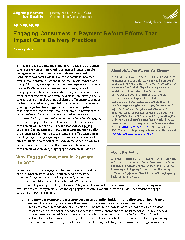Efforts to engage patients and consumers in decisions about their care have evolved to incorporating consumer input and feedback on organizational decisions on how that care is received. Consumers now participate in quality and safety improvement efforts, health system policy and infrastructure discussions, and even public policy development. Attempts to engage consumers in the specific discussions of payment reform design are still emerging, in part because the specifics of payment reform policies seem far removed from—and even invisible to—the average health care consumer. In reality, these policies can affect many aspects of the health care delivery system that directly impact consumers. A growing body of evidence suggests that consumer or patient engagement can lead to better health outcomes, improvements in patient safety and quality, and more control of health care costs. To fully understand and realize the benefits of engaging consumers in payment reform, it is critical to draw on evidencebased practices. This brief outlines the reasons for engaging patients and consumers in the creation of payment reform policy and related care delivery practice discussions, offers examples of how Aligning Forces for Quality communities (Alliances) and other multi-stakeholder organizations can use patient engagement in their own payment reform efforts, and identifies evidence based practices to meaningfully engage consumers in this area.


